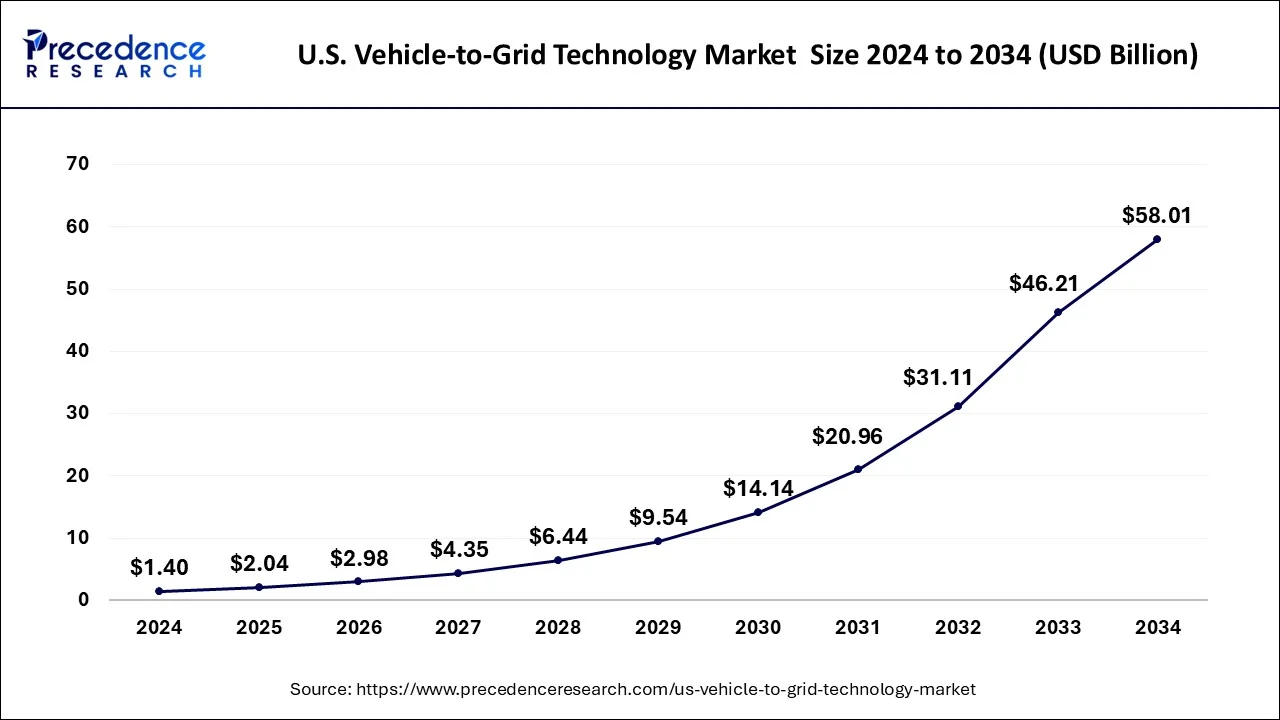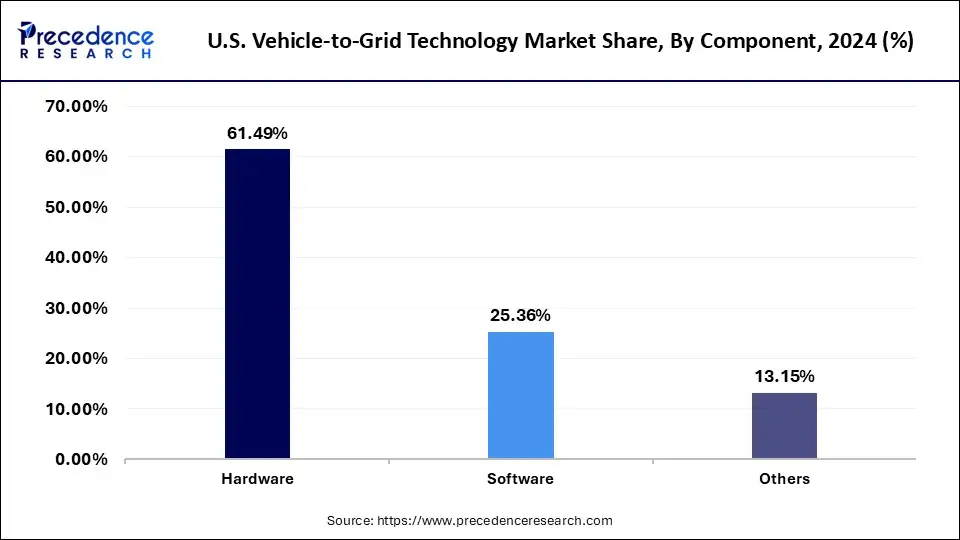List of Contents
U.S. Vehicle-to-Grid Technology Market Size Forecast 2025 to 2034
The U.S. vehicle-to-grid technology market size is estimated at USD1.85 billion in 2025. It is predicted to increase from USD 2.45 billion in 2026 to approximately USD 25.43 billion by 2034, expanding at a CAGR of 33.80% from 2025 to 2034.

U.S. Vehicle-to-Grid Technology Market Key Takeaways
- In terms of revenue, the U.S. vehicle-to-grid technology market was valued at USD 1.4 billion in 2024.
- It is projected to reach USD 25.43 billion by 2034.
- The market is expected to grow at a CAGR of 33.80% from 2025 to 2034.
- By component type, the hardware segment held the major share of 61.49% in 2024.
Market Overview
Through the use of vehicle-to-grid technology, plug-in electric vehicles such as batteries, plug-in hybrid, or hydrogen cell, can now connect to the power grid and get a charge. It also makes it possible for electric cars to store and release electricity produced by renewable energy sources like wind and solar power. But this is still an emerging technology that hasn't seen widespread commercialization. Utilizing underutilized electricity from the automobile, vehicle-to-grid (V2G) technology, also known as vehicle-grid integration (VGI) technology, transfers it to the smart grid. According to estimates, the technology can assist in achieving sustainable energy targets in the near future, such as aiming for zero carbon emissions.
U.S. Vehicle-to-Grid Technology Market Growth Factors
- One of the main reasons propelling the rise in revenue of the U.S. vehicle-to-grid technology market is the growing need for renewable energy sources. As our planet progresses toward a greener and more sustainable future, renewable energy sources like solar and wind power are becoming more and more popular.
- V2G technology makes it possible for EVs to function as Energy Storage devices, which facilitates more efficient use of renewable energy sources. The need for expensive and environmentally harmful fossil fuel power plants may be avoided when renewable energy sources provide more energy than is needed. This excess energy can be stored in electric vehicle batteries and returned to the grid when needed.
- The growth of the U.S. vehicle-to-grid technology market is also being driven by government incentives and restrictions. To encourage EV owners to participate in V2G initiatives, governments in the U.S. are offering tax credits and reimbursements. Rules mandating the use of electric vehicles (EVs) in particular industries, such as public transportation, are also driving up demand for V2G technology.
- As the price of EVs decreases and their range increases, more people are choosing to use electric vehicles instead of traditional gasoline-powered cars. Additional benefits of V2G technology for EV owners include reduced ownership expenses due to revenue generated from excess energy storage.
Market Scope
| Report Coverage | Details |
| Growth Rate from 2025 to 2034 | CAGR of 33.80% |
| U.S. Market Size in 2025 | USD 1.85 Billion |
| U.S. Market Size in 2026 | USD 2.45 Billion |
| U.S. Market Size by 2034 | USD 25.43 Billion |
| Base Year | 2024 |
| Forecast Period | 2025 to 2034 |
Market Dynamics
Driver
Increasing sales of electric cars (EVs)
The U.S. vehicle-to-grid technology market is now seeing unprecedented growth due to the rise in EV purchases, which is also propelling the shift towards cleaner and more sustainable energy solutions. The idea of deploying electric vehicles (EVs) as mobile energy storage units is central to the V2G concept. These cars can be hooked up to the grid while not in use, which would enable the batteries to store extra energy produced by renewable sources.
The increasing acceptance and knowledge of EVs among consumers is driving a comparable trend for V2G systems. Additionally, as customers learn more about EVs and their advantages, the concept of V2G is gaining popularity. Car batteries are becoming more and more acceptable to owners as a means of storing and transferring energy in addition to being used for driving. The V2G market in the United States is growing as a result of this change in customer perception and behavior.
Restraint
Standardization and battery degradation concerns
One major obstacle could be the absence of established protocols and compatibility across various V2G systems. To ensure that V2G-enabled electric cars can interact with different grid management systems and charging infrastructure, standardization is essential. Furthermore, there are worries regarding rapid battery deterioration due to the bidirectional usage of electric car batteries for grid services.
The long-term condition and longevity of the vehicle's battery may be impacted by the frequent charge-discharge cycles connected to V2G activities. It is imperative to tackle these issues to guarantee the financial sustainability of V2G systems. Thus, the standardization and battery degradation concerns act as a major restraint for the U.S. Vehicle-to-Grid Technology Market over the projected period.
Opportunity
Rising acceptance of smart grids
The U.S. vehicle-to-grid technology market is undergoing a positive and revolutionary shift due to the growing popularity of smart grids. Smart grids' primary advantage is their capacity to intelligently balance energy supply and demand, improving the stability, dependability, and efficiency of the system. V2G networks contribute to this strength by serving as a versatile energy source. EVs that are linked to the smart grid can store excess energy during times of low demand and reintegrate it into the system during moments of peak demand.
This capacity to distribute electricity efficiently and avoid blackouts or problems with power quality is greatly aided by the ability to balance the load. Furthermore, the usage of renewable energy sources is encouraged by the spread of smart grids, which is essential for V2G technology. Solar and wind power integration is something that smart grids are made to better handle and accept. Therefore, the increasing acceptance of smart grids is expected to offer a lucrative opportunity for the U.S. vehicle-to-grid technology market over the projected period.
Component Type Insights
In 2025, the hardware segment dominated the U.S. Vehicle-to-Grid (V2G) technology market, capturing the largest share of 61.20%. This dominance is primarily due to the critical role of hardware components such as bidirectional chargers, inverters, and communication devices, which are essential for enabling efficient energy transfer between electric vehicles (EVs) and the grid. The growing adoption of electric vehicles, coupled with increasing investments in energy infrastructure and smart grid technologies, has significantly boosted demand for robust and reliable V2G hardware. Additionally, government incentives and utility programs aimed at promoting renewable energy integration have further strengthened the hardware segment's market position.

The software segment of the U.S. V2G technology market is projected to grow at the fastest rate during the forecast period, driven by the increasing need for advanced energy management, predictive analytics, and real-time monitoring solutions. V2G software enables seamless communication between EVs, charging stations, and the power grid, optimizing energy flow, demand response, and load balancing. As utilities and fleet operators seek to maximize grid efficiency and reduce operational costs, the adoption of sophisticated V2G software platforms is accelerating, creating significant growth opportunities in the market.
U.S. Vehicle-to-Grid Technology Market Companies
- ABB
- AC Propulsion, Inc.
- Edison International
- EV Grid, Inc.
- Fermata Energy
- Hitachi, Ltd
- Honda Motor Co., Ltd.
- NRG Energy, Inc
- Nuvve Holding Corp.
- Wallbox Inc
Recent Developments
- In January 2025, Nuvve Holding Corp. introduced a new product line of bidirectional and unidirectional chargers (20 kW–360 kW), designed for fleets, public infrastructure and microgrid applications.
- In August 2025, Eaton and ChargePoint jointly launched a high‑power DC V2X charger/infrastructure solution (ChargePoint Express Grid) that supports up to 600 kW for passenger EVs and megawatt‑scale for heavy-duty fleets.
Segments Covered in the Report
By Component Type
- Hardware
- Bidirectional Chargers (AC, DC)
- Vehicle-side Bidirectional Electronics
- Grid Integration Hardware
- Software
- Smart Charging and Energy Management
- Aggregator/VPP Platforms
- Connectivity/cloud Services
- Services
- Installation and Commissioning
- O&M Services
- Energy Trading / Grid Services Revenue
For inquiries regarding discounts, bulk purchases, or customization requests, please contact us at sales@precedenceresearch.com
Frequently Asked Questions
Ask For Sample
No cookie-cutter, only authentic analysis – take the 1st step to become a Precedence Research client